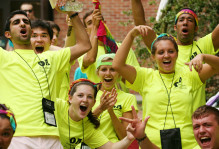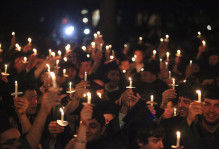Sir Christopher Wren and 5 Other Little Known Facts about the College
At the beginning of every tour, I bring prospective students and their family members through the Christopher Wren building-the oldest academic building in use in the United States. I briefly speak about the history of Wren, College traditions that take place in the Courtyard, and eventually pass through the first floor of the building. Last week, as my tour walked out the main doorway toward Colonial Williamsburg, a gentleman raised his hand and asked, “Who is Christopher Wren?” I thought for a few seconds (it felt like a few hours) and ultimately realized that I didn’t know. As you can probably guess, I was pretty ashamed of myself and slightly embarrassed. Here was a building that I spoke about on an almost daily basis, and I couldn’t even give the gentleman one or two facts about Christopher Wren.
Once the tour ended, I asked a few other students in the Admission Office and found that I was not alone-the majority knew very little to nothing about Wren. Of course, all tour guides could tell you about the dates of construction, the various ceremonies that take place in the Great Hall, and even the number of current classrooms found inside, all the while dropping the name “Christopher Wren” as if he were just another student on campus. I think this is a perfect example of one of those little known facts about our campus that most people don’t really think about or take the time to research.
Hoping that this sort of incident would never happen again, I raced home after work, immediately flipped to the page in my tour guide manual about the Sir Christopher Wren, and found my answer. Wren was a renowned 17th century English architect to whom an 18th century author attributed the design of the Wren building (originally called “the Main Building”). I also recently discovered that there is even a wine named after Christopher Wren at the Williamsburg Winery, which benefits the W&M Alumni Association. Needless to say, Sir Wren is a pretty important person to the College, and I’m happy to say that the next time I’m asked a question about him on a tour, I will have plenty to say. If the gentleman who originally asked me this question is reading, I would like to apologize for not having an answer. I hope this is a little bit more helpful!
Now, as I started to write this blog, I realized that there are many more “little known facts” about the College and student life in Williamsburg-things that students may know but that are otherwise unfamiliar to those not on our campus. So, without further ado, I present to you my version of “5 Little Known Facts and Other Things You Would Never Think to Ask about the College.” Consider this William and Mary 101…
Once again, these facts may already be well-known among students but new to families and visitors. Enjoy!
1. The Thomas Jefferson statue found between Washington Hall and McGlothlin-Street Hall was a gift from the University of Virginia in 1993-our 300th anniversary. Today, students like to dress “TJ” in all sorts of clothes, including pumpkins, Santa
Claus hats, and boxers.
2. We have a lake on campus! Most people do not know that Lake Matoaka exists until they join our community. It’s a great place to spend an afternoon, especially when the weather is nice. Not only are there canoes and kayaks available for students to rent, but there is even an amphitheater, which is really popular for student events and concerts.
3. Students have full AND free access to all of the museums and exhibits in Colonial Williamsburg (with a student ID). A 1-day “Basic Adult Pass” usually costs $36, so this is a great benefit of being at student at the College. I also recently learned that students receive an almost-50% discount off of carriage rides in Colonial Williamsburg.
4. The basement of the Sadler Center (right next to Quiznos) is named Lodge 1 because it was originally the location of an 8th lodge on campus. What is a lodge? There are currently seven lodges on campus, which each house seven students and are all equipped with a double, a triple, a spacious living room/kitchen area, two bathrooms, a front porch, and a back patio. According to the Residence Life website, “Lodges are one of the most popular housing options on campus, usually the first to be selected during the annual Room Selection Process.”
5. The Sunken Garden (the grassy area at the center of Old Campus) was modeled after the Chelsea Hospital gardens in London. Despite popular belief, it did not in fact sink on its own-this was part of the design. During the Revolutionary War, it was also used as a campground before troops joined General George Washington in Yorktown. Today, the Sunken Garden is a popular spot to play frisbee or football, hang out with friends, or just enjoy the weather.
That’s all for now. I hope you all learned at least one or two things about the College-even the students! If you can think of any other “little known facts” about William and Mary, I would love to hear about them and add them to my blog. Feel free to send me an e-mail at [[rleick]].
Have a fantastic week!
Ryan




No comments.
Comments are currently closed. Comments are closed on all posts older than one year, and for those in our archive.